Introduction
Each year, 36 million people worldwide die from noncommunicable diseases.
These ailments, such as cardiovascular diseases, certain cancers, chronic respiratory disorders and diabetes, account for 63% of deaths worldwide and are largely the result of lifestyle choices. The World Health Organization attributes nearly all of these premature deaths to smoking, unhealthy diet, physical inactivity and harmful use of alcohol.[1] According to Dr. Ralph Keeney of Duke University, “The leading cause of death is personal decision making…. Making better personal decisions could potentially prevent millions of premature deaths per decade.”[2]
The “Quantified Self” movement encourages individuals to take a greater interest in their wellness through utilization of fitness apps and activity monitors. [3] Wearable technology and medical devices are becoming more common, and their capabilities are expanding beyond tracking a person’s movement to include heart rate and sleep monitoring. Technological advancements now allow personal devices to continuously monitor multiple health-related functions.
Wearable devices are often used to verify physical activity as part of incentivized wellness programs being developed in markets worldwide. As the technology improves, wearable devices will play a role in insurance program offerings and may potentially assist in point-of-sale underwriting.
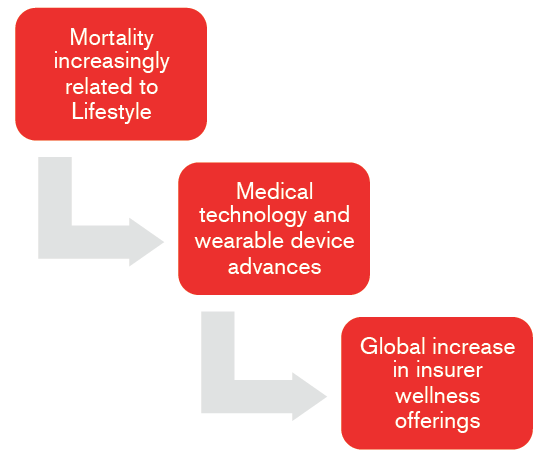
Lifestyle-Related Mortality
Mortality rates have been in decline over the last century, driven in large part by improvements in communicable disease mortality. Deaths from chronic conditions, including cardiovascular conditions, lung disease, diabetes, and cancer, are largely lifestyle-related, and they began to increase in the U.S. in the middle of the 20th century. Currently, more than 80% of deaths in the U.S. are related to chronic conditions.[4]
U.S. Death Rates by Cause
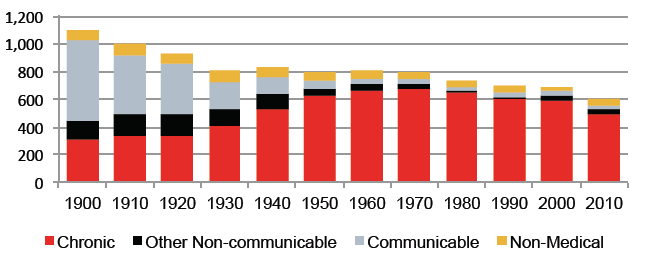
This trend is not limited to the United States. Over 60% of deaths globally are due to chronic disease, and the shift of disease burden from communicable to chronic diseases is increasing faster in developing countries than what was historically experienced in industrialized nations. It is estimated that by 2020, chronic disease will account for three-quarters of all deaths.[5]
Death from chronic disease can be attributed to behavior. According to the Oxford Health Alliance 3-4-50 initiative, three lifestyle behaviors lead to four chronic conditions that account for over half of deaths worldwide.[6]
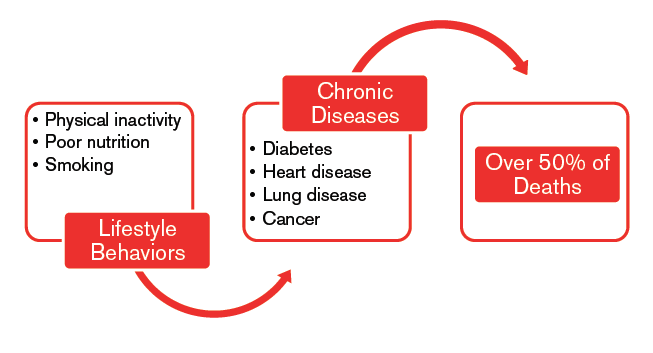
Current State of the Market for Wearable Technology
There have been significant advances in bio-sensing medical devices. With aspirations of becoming real-world versions of the Star Trek “tricorder” [a medical device with sensing, computing and recording capabilities], products such as the Scanadu Scout™ hold great promise for individualized care.[7] Similarly, technological inventions such as Samsung Gear S provide users with portable technology and enhanced connectivity. The intersection of these technologies is biosensing wearable devices.
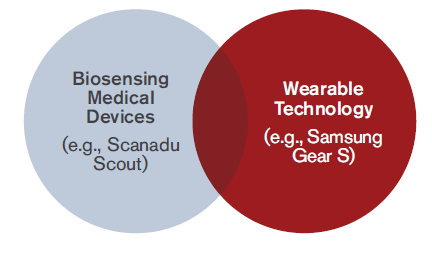
Usage
Wearable devices are commonly used to monitor fitness. (A comparison of the capabilities of several fitness focused wearable devices is in Appendix A.) In addition to movement tracking, these devices also monitor sleep or heart rate, often without a chest strap. Fitness-related wearables are typically in the form of a bracelet or smart watch, and users can sync them to a mobile phone. A few of these devices also track additional information such as body temperature, blood oxygen level and respiration.
Wearable devices can track a variety of health-related measures. Heart function can be monitored with a device that tracks heart rate variability and blood pressure. Devices can assist with continuous remote patient monitoring to reduce the number of days a patient is hospitalized or to allow older adults to live safely at home. Some devices can be used to promote brain health and others to monitor glucose in diabetic patients. (A comparison of health-related wearable devices is in Appendix B.)
The market for wearable technology is dynamic. New products designed to monitor a variety of health metrics in addition to physical activity are entering the market all the time.
Many popular wearable devices designed to monitor activity either clip onto clothing or are worn on the wrist as a bracelet. The latest innovation in wearables is “smart clothing.” Fitness apparel such as caps, shirts and pants can track movement and heart rate; socks can track steps, distance and speed. A listing of several types of smart clothing is in Appendix C.
Beyond clothing, there are advances in bio-sensing tattoos, which can quantify the level of exertion expended in a workout[8] or continuously monitor body temperature, movement and heart rate.[9] Google is working to develop contact lenses that will monitor glucose level.[10] Wearable devices have expanded health-tracking capabilities beyond simple pedometers.
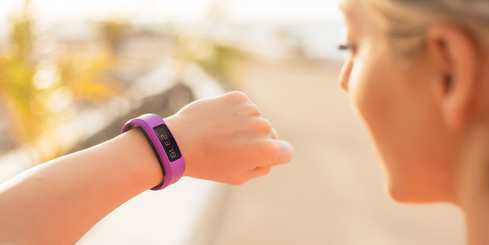
Wearable Technology Market Trends
Usage Trends
Awareness and usage of wearables are on the rise. A survey from Endeavor Partners suggests that 35% of wearable tech users obtained their device less than three months ago and more than 60% obtained the device within the last six months.[11] According to a March 2014 Nielsen survey, 70% of consumers were aware of wearables and 15% were already using wearable technology in their daily lives.[12]
Most wearable technology owners are younger and more affluent. According to Nielsen, nearly half are between 18 and 34 years old and 29% make more than $100,000 in annual income. Fitness bands are the most popular devices [61%], followed by smart watches [45%]. Fifty-seven percent of fitness band users said that self-monitoring and health concerns were major factors motivating their usage.[12]
One concern is whether users who purchase a device remain committed to using it. Endeavor Partners’ research suggests nearly one-third of users who obtained a device more than 12 months ago are no longer using it today. Abandonment rates have decreased, however, as the devices’ functionality, battery life and style have improved.
Market Forecast
The wearable technology market has grown dramatically in recent years, but forecasts for the future vary dramatically. Research from Gartner estimates that more than 70 million wearable electronic fitness devices were sold in 2014, with the biggest growth forecast in the “Smart Garment” category. Gartner believes that smart watches [which are not included in these numbers] will become favored over smart wristbands by 2015. [13]
Juniper Research predicts that nearly 130 million units will be shipped worldwide in 2018.[14] Credit Suisse has called wearable tech the “Next Big Thing” and predicted that the market will explode from between $3 and $5 billion in 2013 to $50 billion over the next three to five years.[15] A 2014 BCC research report is similarly optimistic, predicting that the global market will reach $30.2 billion by 2018.[16]There is a significant amount of uncertainty in these projections, however, as they rely on unknown future developments in bio-sensing technology and unproven customer demand. It is unclear if the popularity of these devices will fizzle out, or if they will grow to permeate daily life as smartphones have.
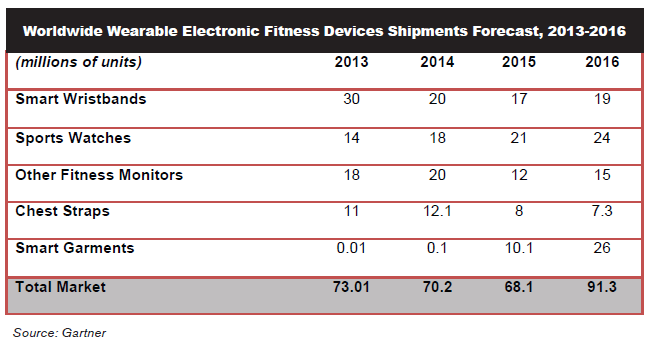
Aggregation of Data Across Platforms
Device manufacturers are beginning to consolidate tracking capabilities. Leading fitness-monitoring device maker Jawbone recently announced it is opening its software app to work with other devices. Jawbone has stated, “We believe that the future of activity tracking hinges on companies allowing their smart algorithms to run cross platform and gather information from multiple sources.”[17] The open platform will allow for easier integration of fitness and nutrition data. Similarly, Apple announced a partnership with Epic and Mayo Clinic to integrate health data from the Apple Watch and Apple HealthKit with hospital electronic health records.[18]
In order to realize the value in aggregated data, companies will need to summarize and analyze the data in meaningful ways. Many companies are involved in fitness and health monitoring, and aggregation of data will be a challenge for the smaller companies competing with major players such as Apple.
Device Makers Launching Wellness Programs
Fitness-monitoring device makers such as Garmin, Fitbit and Fitbug are expanding their offerings into corporate wellness programs, with participant activity validated by their devices. [19] [20] [21] The wellness programs are not limited to fitness tracking, however. They also include incentivized rewards and challenges, as well as social interaction among employees.
Fitness Communities
Individuals using wearable technology can network through companies, such as EveryMove, that provide a communication platform and rewards for quantified activity. Members can earn discounts on merchandise or make charitable donations as a result of engaged activity.[22] MANA Nutrition began an initiative to incentivize wellness through philanthropic donations. Participants are able to provide ready-to-use therapeutic food [RUTF] to undernourished and malnourished children in exchange for quantified activity.[23]
Wellness-Related Insurance Offerings
Wellness-related insurance discounts were pioneered by the South African company Discovery Insurance in 2000. Incentivized wellness programs reward healthy behavior with insurance discounts, and loyalty rewards are becoming more common in all parts of the world.
Generally these programs require demonstrable activity in order to qualify for rewards. A typical way to quantify activity is through fitness devices, many of which track movement as well as heart rate and sleep.
These programs can be designed to attract already fit and healthy people. Alternatively, programs can be designed to encourage healthy behavior from those with chronic conditions. For example, customers with elevated BMI, cholesterol or blood pressure can receive standard rates and qualify for discounts if wellness goals are attained after a number of years.
Insurance wellness programs typically require periodic health assessments as well as doctor visits in order to assess the effectiveness of a policyholder’s activity. As medical technology improves to accurately measure and assess additional physical characteristics, wearable devices can provide value to insurers beyond basic movement tracking.
Effectiveness
The relationship between physical fitness and improved health has been studied extensively for many years. Physical fitness is associated with lower all-cause mortality due to lower rates of cardiovascular disease and certain cancers.[24] Programs that focus on increasing physical activity can be effective in reducing the risk of cardiovascular disease.[25] Additionally, research has found that exercise activities can reduce the risk of chronic conditions such as diabetes, osteoporosis and depression.[26]
Wellness programs have gained popularity among employers and health insurers as a way to reduce the costs of chronic diseases. The effectiveness of wellness programs is often measured by the return on investment – the cost of administering the wellness program relative to healthcare cost savings. Studies regarding wellness program effectiveness have produced varied findings. A Harvard University study found that, on average, a corporate wellness program saves $3 in medical costs for each $1 invested in wellness.[27] On the other hand, a study by the RAND Corporation found that investments in lifestyle management were less effective in reducing healthcare costs than investments aimed at reducing the cost of ailments resulting from chronic diseases.[28] Further, cost savings do not materialize until a wellness program has been in operation for at least five years.[29]
Protection insurance experience may improve from wellness-related products. While wellness-related protection insurance products have expanded in recent years, the majority of these offerings are too new to have published results regarding the effectiveness of wellness programs. However, the wellness program Vitality has published research showing that wellness programs are effective in improving protection insurance experience. Policyholders with a high level of wellness program engagement were found to have lower healthcare costs.[30] Further, insurance claims and lapse experience for highly engaged participants in the Vitality wellness program is better than for those with low engagement.[31]
Wearable technology can be used to verify activity and participation in wellness programs; however, there are few formal studies ascertaining the accuracy of wearable devices. The U.S. Food and Drug Administration [FDA] regulates medical devices, which may include some health-monitoring wearables. However, fitnessmonitoring
wearable technology is not regulated as a medical device and may therefore lack the desired level of accuracy. The majority of these devices rely on accelerometers and GPS to measure movement, and the same activity may produce different results on various devices.[32] Further, devices that measure heart rate through a separate chest strap may be more accurate than bracelets that monitor heart rate without additional equipment.[33] As wearable technology plays an increasingly important role in wellness program design, verification of its accuracy becomes imperative.
Conclusion
Lifestyle choices are contributing to a greater percentage of premature deaths. Consequently, insurers are developing products that can utilize wearable technology to verify physical activity and monitor health. The market for wearable devices and technology continues to expand; device makers are evolving to gain access to additional streams of data and incentivize behavior with financial rewards; and new online fitness communities motivate participants with donations to charity as a reward. An effective wellness program design and wearable technologies that generate consistently accurate results are necessary to the success of wellness-related insurance offerings.
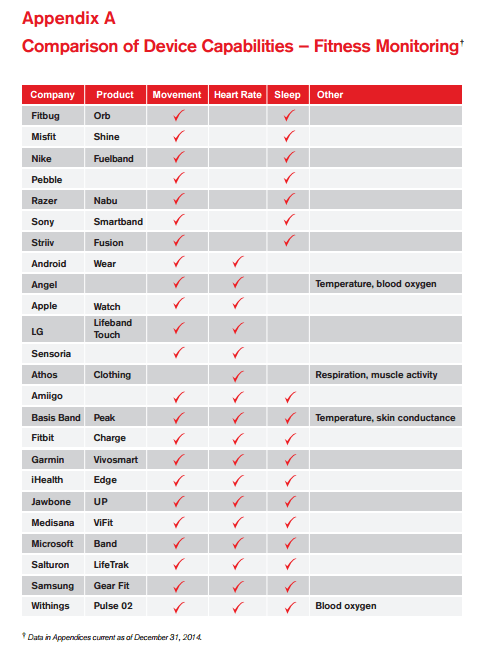
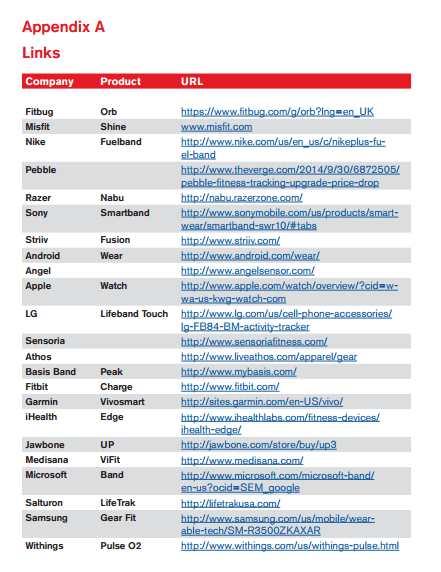
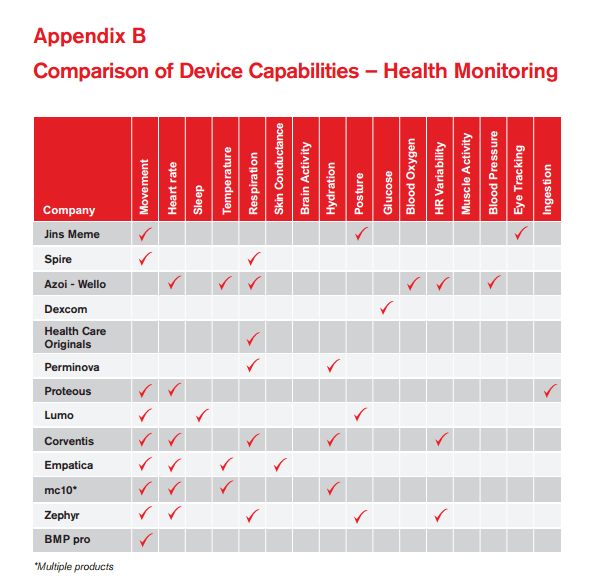
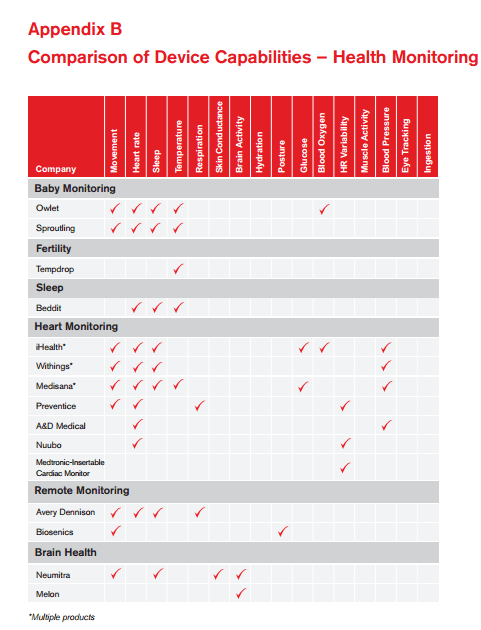
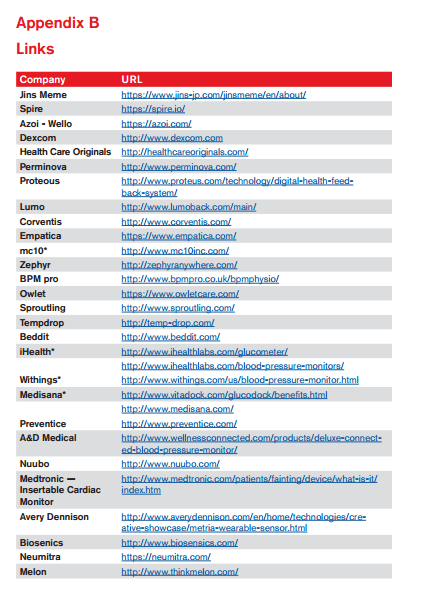
Appendix C
Clothing
- Netatmo June – Sun-monitoring bracelet
https://www.netatmo.com/en-US/product/june - Reemo – Home automation system controlled by a bracelet, designed to empower the elderly and the chronically ill
http://www.getreemo.com/ - Spree Sportcap – Monitors heart rate
http://spreewearables.com/ - Myo – Gesture control arm band
https://www.thalmic.com/en/myo/ - Nuviun – A smart bra to detect breast cancer
http://nuviun.com/content/blog/smar-bra - Nuviun – Nicotine patch smart watch
http://nuviun.com/content/blog/SmartStop - Zoll Lifevest – The LifeVest wearable defibrillator is worn by patients at risk for sudden cardiac arrest: http://lifevest.zoll.com/
- Lifebeam Cycling helmet – Monitors calories and heart rate
http://www.life-beam.com/product/helmet/ - Ybrain – Headband device to stimulate the brain to treat Alzheimer’s patients
http://ybrain.com/ - Smart Insert for peripheral neuropathy
http://orpyx.com/ - Leg band for chronic pain management
http://www.neurometrix.com/ - Esight glasses that allow legally blind to see
http://www.esighteyewear.com/frequently-asked-questions - Orcam – Glasses with camera for visually impaired
http://www.orcam.com/ - AIQ Bio monitoring Smart Clothing
http://www.aiqsmartclothing.com/ - OMsignal – Sportswear that records heart rate and other vital data for fitness use: http://www.omsignal.com/
- Myjacket – App-controlled hug jacket to comfort children with autism
http://www.mytjacket.com/ - Sensoria Fitness smart sock – Tracks steps, speed and distance
http://www.sensoriafitness.com/















